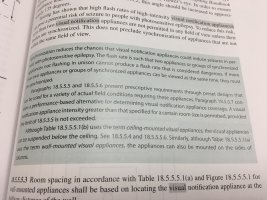NFPA 18.5.5.4.2 states “ Visible notification appliances shall be installed in accordance with Table 18.5.5.4.1(a) or Table 18.5.5.4.1(b) using one of the following: (2) Two groups of visible notification appliances, where visual appliances of each group are synchronize, in the same room or adjacent space within the field of view. This shall include synchronization of strobes operated by separate systems.”
I believe this to be interpreted as the two groups of strobe being out of sync would be the same as two individual strobes being out of sync. As of 1996 the strobe rate was adjusted so that two strobe could not exceed the 5 flashes per second that would potentially cause epileptic seizures. This would hold true for the two distinct groups just as it would for two strobes being out of sync with a max combined flash rate of 4 per second.
My dilema is in a larger building with two physical addresses. Each address is protected by a dedicated fire alarm system and all notification devices within that address are synchronized. The two systems are networked together for shared function but the two systems are not synchronized together due to differing strobe protocols. When one address is in alarm it only causes a supervisory in the adjacent address and vice versa. The issue arises in common corridors when both systems are in an alarm condition. Each group/ system of notification appliances is synchronized but the two are creating different two strobe patterns.
Am I wrong to feel that we are compliant in this situation of two groups not synchronized in common corridors ? I understand the AHJ has the final determination but I believe my interpretation is defendable
I believe this to be interpreted as the two groups of strobe being out of sync would be the same as two individual strobes being out of sync. As of 1996 the strobe rate was adjusted so that two strobe could not exceed the 5 flashes per second that would potentially cause epileptic seizures. This would hold true for the two distinct groups just as it would for two strobes being out of sync with a max combined flash rate of 4 per second.
My dilema is in a larger building with two physical addresses. Each address is protected by a dedicated fire alarm system and all notification devices within that address are synchronized. The two systems are networked together for shared function but the two systems are not synchronized together due to differing strobe protocols. When one address is in alarm it only causes a supervisory in the adjacent address and vice versa. The issue arises in common corridors when both systems are in an alarm condition. Each group/ system of notification appliances is synchronized but the two are creating different two strobe patterns.
Am I wrong to feel that we are compliant in this situation of two groups not synchronized in common corridors ? I understand the AHJ has the final determination but I believe my interpretation is defendable


